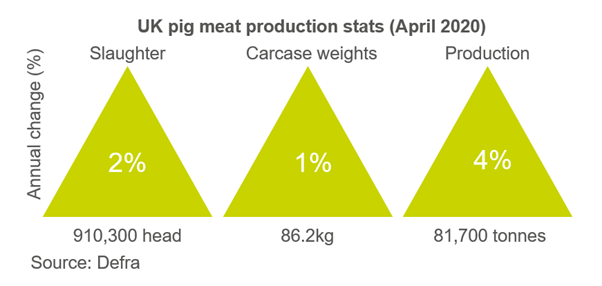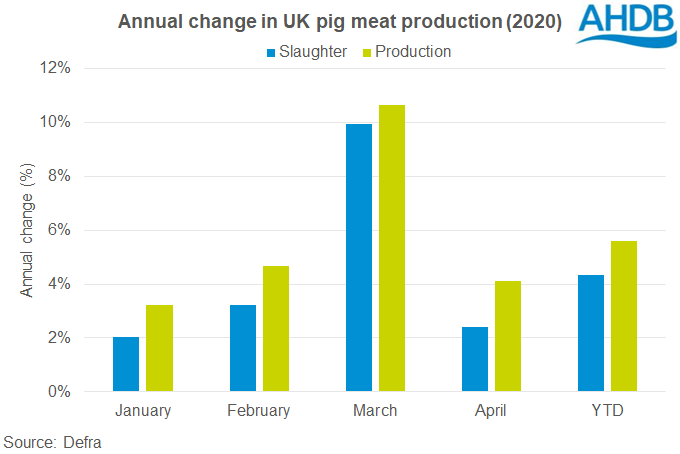Higher slaughter supports UK pig meat production in April
Thursday, 14 May 2020
By Felicity Rusk

In April, UK clean pig slaughter totalled 910,300 head, 2% more than in April 2019, according to the latest data released by Defra. With the same number of working days as last year, the uplift maybe due to processors encouraging producers to bring forward pigs close to finishing in early April. Nevertheless, we continue to see growth in throughputs despite industry report suggest tightening of supplies of finishing pigs.
Throughputs in Northern Ireland recorded a considerable uplift in April. England and Wales also recorded an uplift, although it was comparatively smaller. In contrast, slaughter in Scotland actually dropped back.
- England and Wales ↑1% to 731k head
- Scotland ↓1% to 27k head
- Northern Ireland ↑9% to 152k head
As such, in the first four months of this year, UK clean pig slaughter totalled 3.68 million head. This is 4% more (152,800 head) than in the same period last year. However, it should be noted that the higher slaughter in March alone accounts for over 55% of the uplift so far this year.

Carcase weight
Finished pig carcase weights in April averaged 86.2kg, 1.0kg (1%) more than in the same month last year. While this is still ahead of last year, it is 0.4kg lower than average weights seen in March. A seasonal decline in weight is typically seen at this time of year. Nevertheless, this could also be due to processors encouraging producers to pull pigs near finishing forward when the quarantine measures were introduced at the end of March. As such, some of these lighter animals may have been still coming forward in early April, which will have reduced the overall average.
Adult pig slaughter
Slaughter of sows and boars recorded a significant uplift in April. Adult slaughter reached 22,500 head, 20% more (3,700 head) more than in the same month last year. This is the highest monthly throughput since January last year. With the cull rate relatively low across last year, the age profile of the herd will have risen. As such, we expected to see an uplift in culling rates this year.
The rapid escalation of the pandemic may have also given producers the incentive to adopt a harder culling policy. Sow prices have moved down and there are reports that highlight concerns over traditional end markets. Nevertheless, for some producers, taking a lower price may be more economical than keeping that animal on.
Production
UK pig meat production reached 81,700 tonnes in April, 4% (3,200 tonnes) more than in the same month last year. As such, production in the first four months of this year totalled 329,800 tonnes, 6% (17,500 tonnes) more than in the same period last year. However, March alone accounts for almost half of the overall growth seen this year.
Sign up for regular updates
Subscribe to receive pork market news straight to your inbox. Simply complete our online form.
While AHDB seeks to ensure that the information contained on this webpage is accurate at the time of publication, no warranty is given in respect of the information and data provided. You are responsible for how you use the information. To the maximum extent permitted by law, AHDB accepts no liability for loss, damage or injury howsoever caused or suffered (including that caused by negligence) directly or indirectly in relation to the information or data provided in this publication.
All intellectual property rights in the information and data on this webpage belong to or are licensed by AHDB. You are authorised to use such information for your internal business purposes only and you must not provide this information to any other third parties, including further publication of the information, or for commercial gain in any way whatsoever without the prior written permission of AHDB for each third party disclosure, publication or commercial arrangement. For more information, please see our Terms of Use and Privacy Notice or contact the Director of Corporate Affairs at info@ahdb.org.uk © Agriculture and Horticulture Development Board. All rights reserved.

